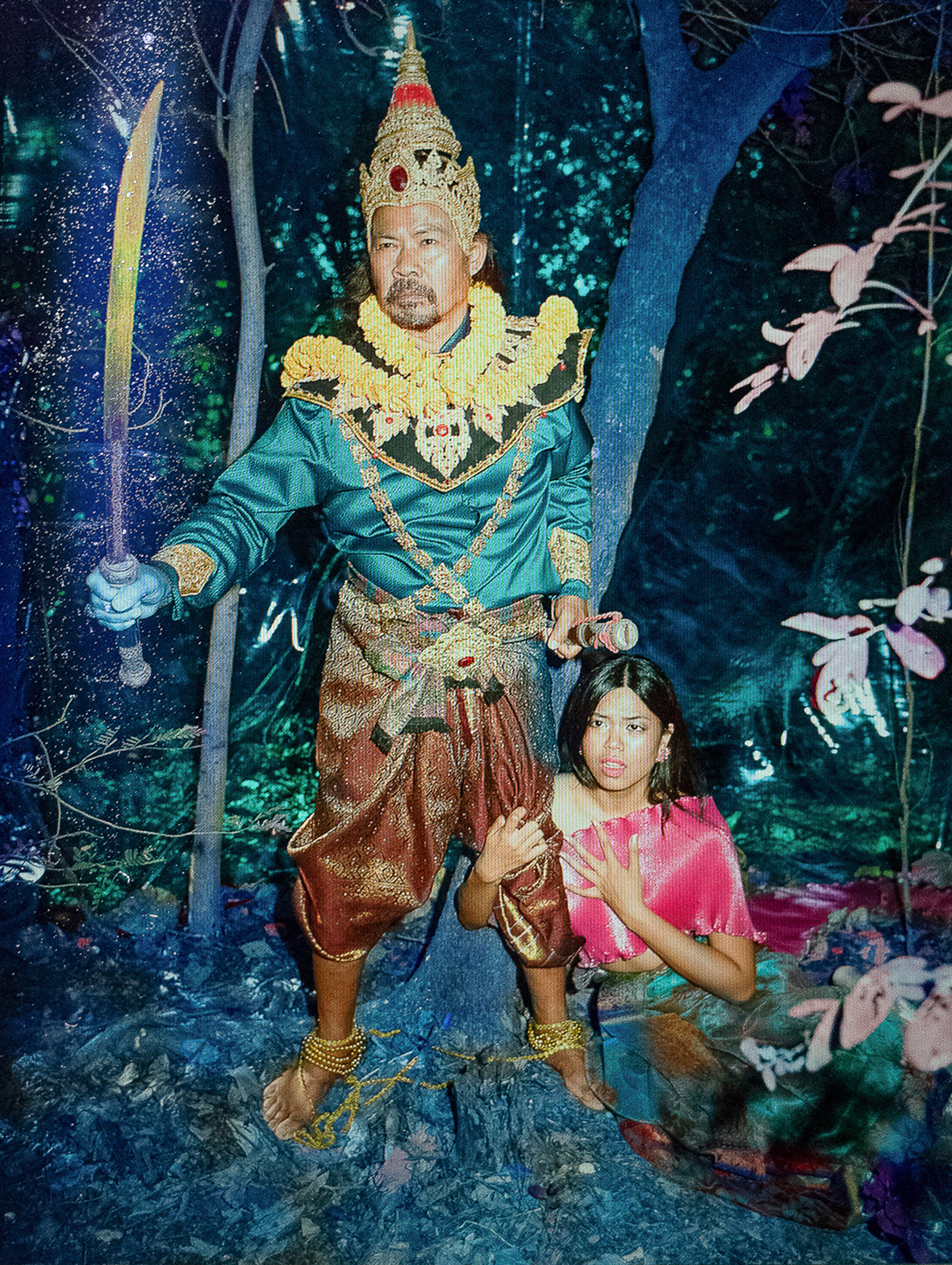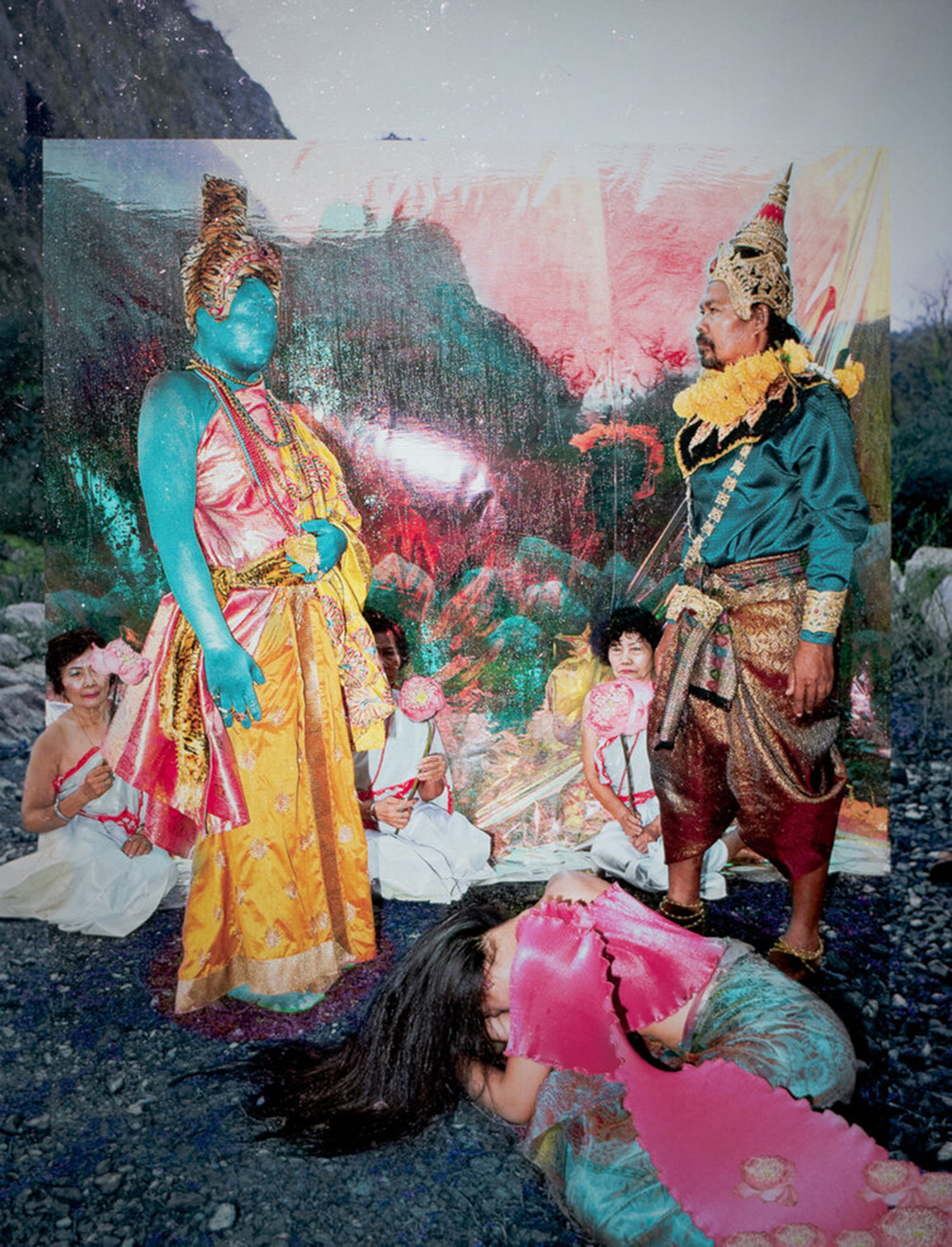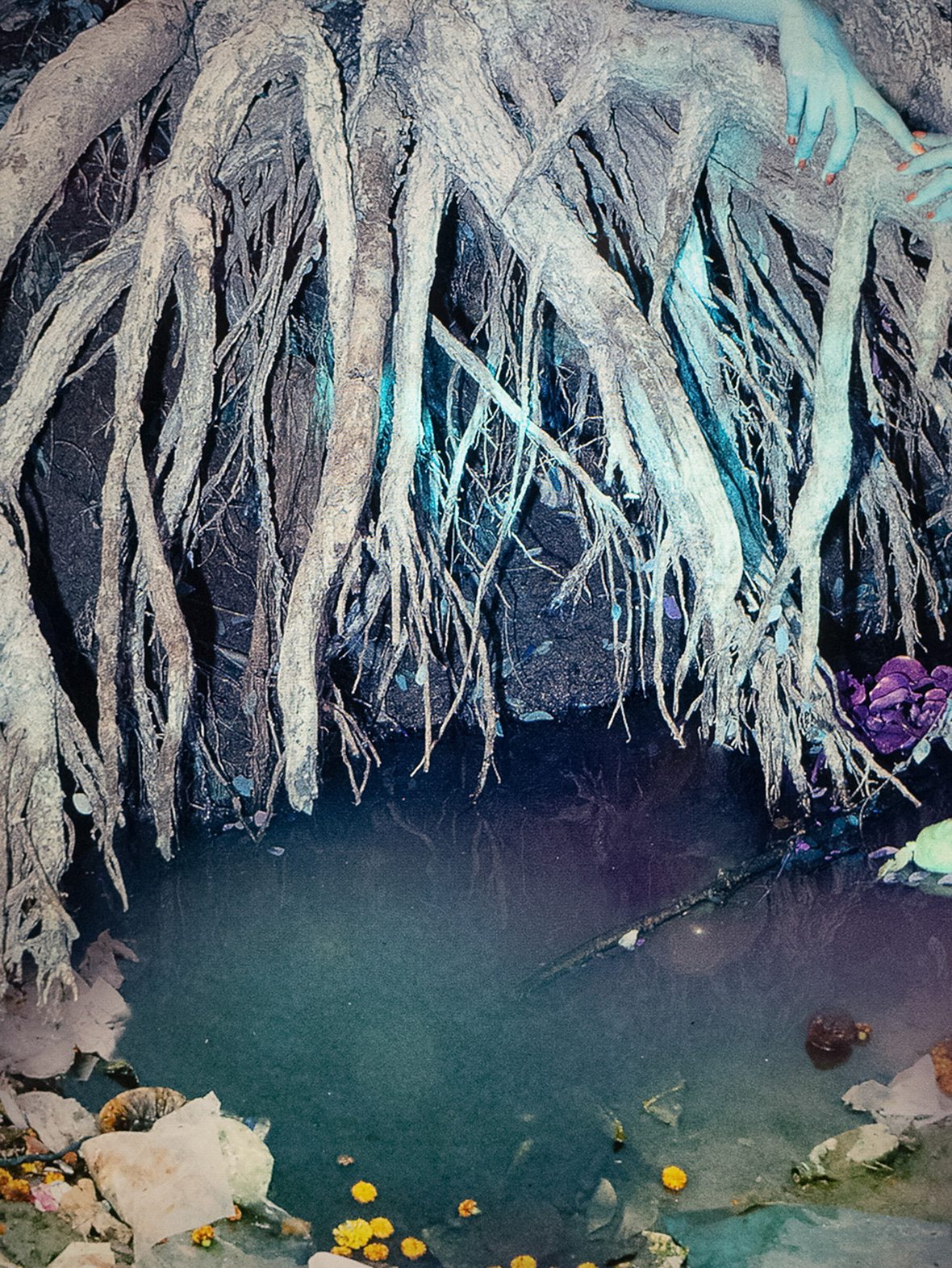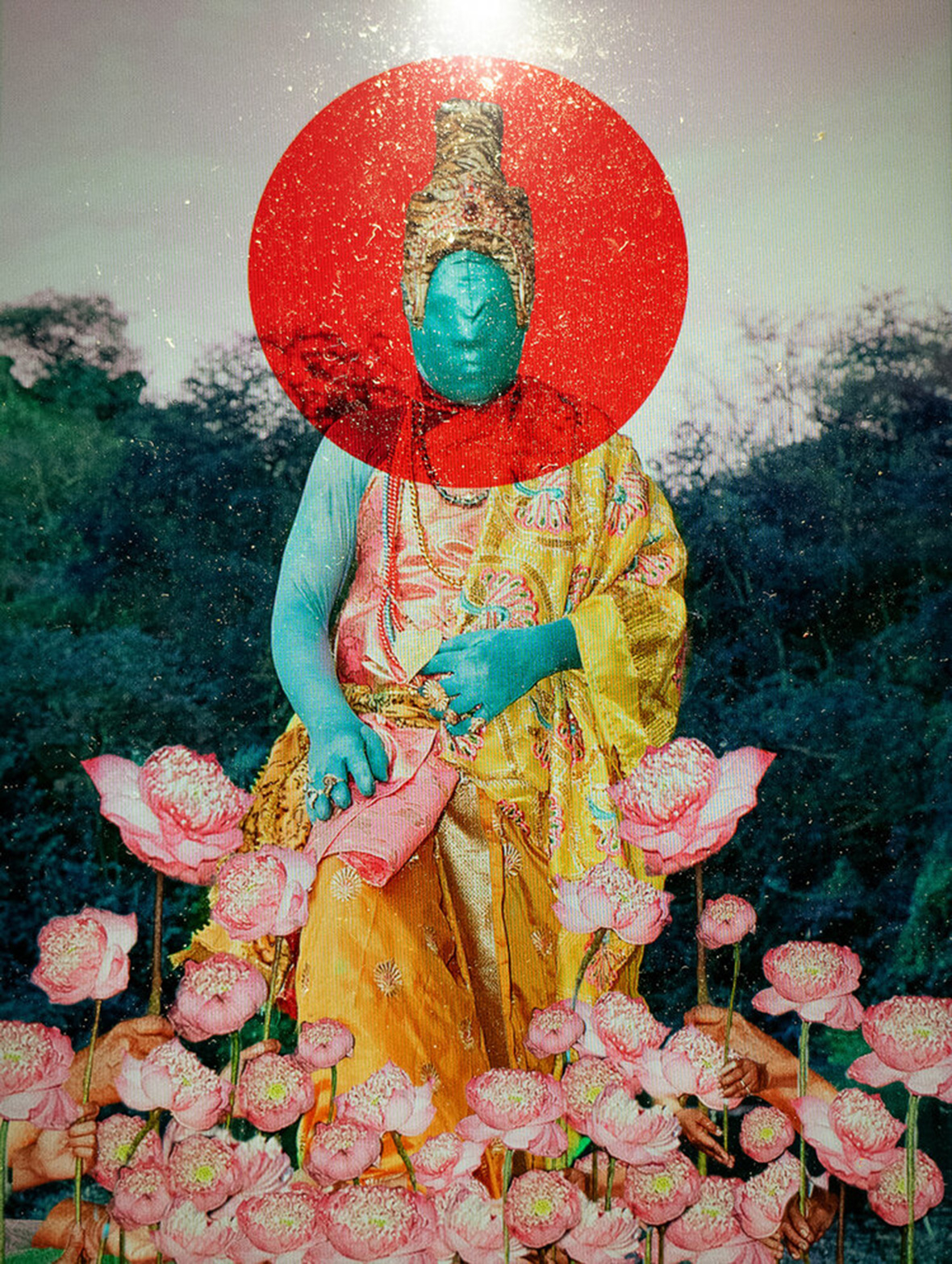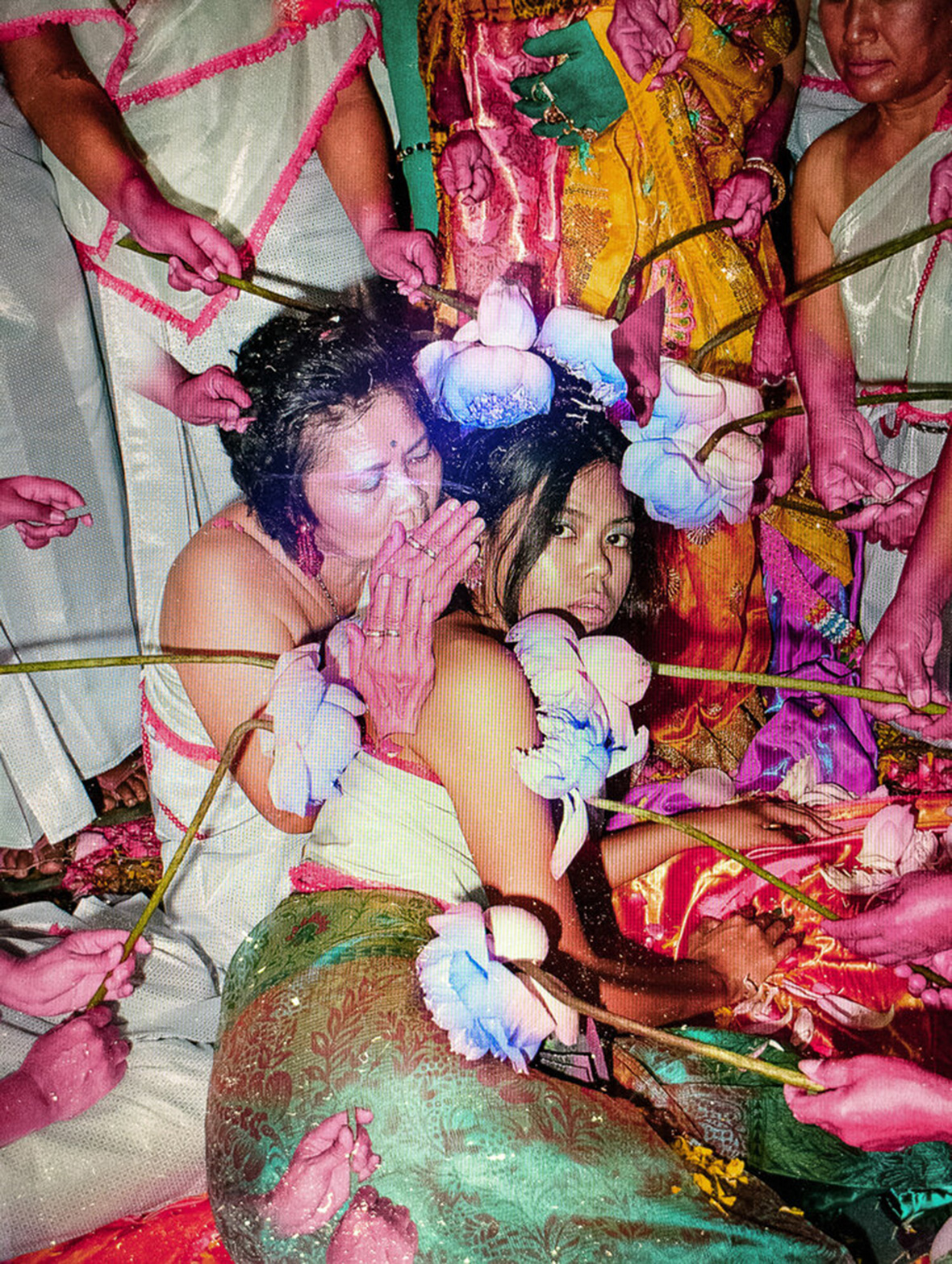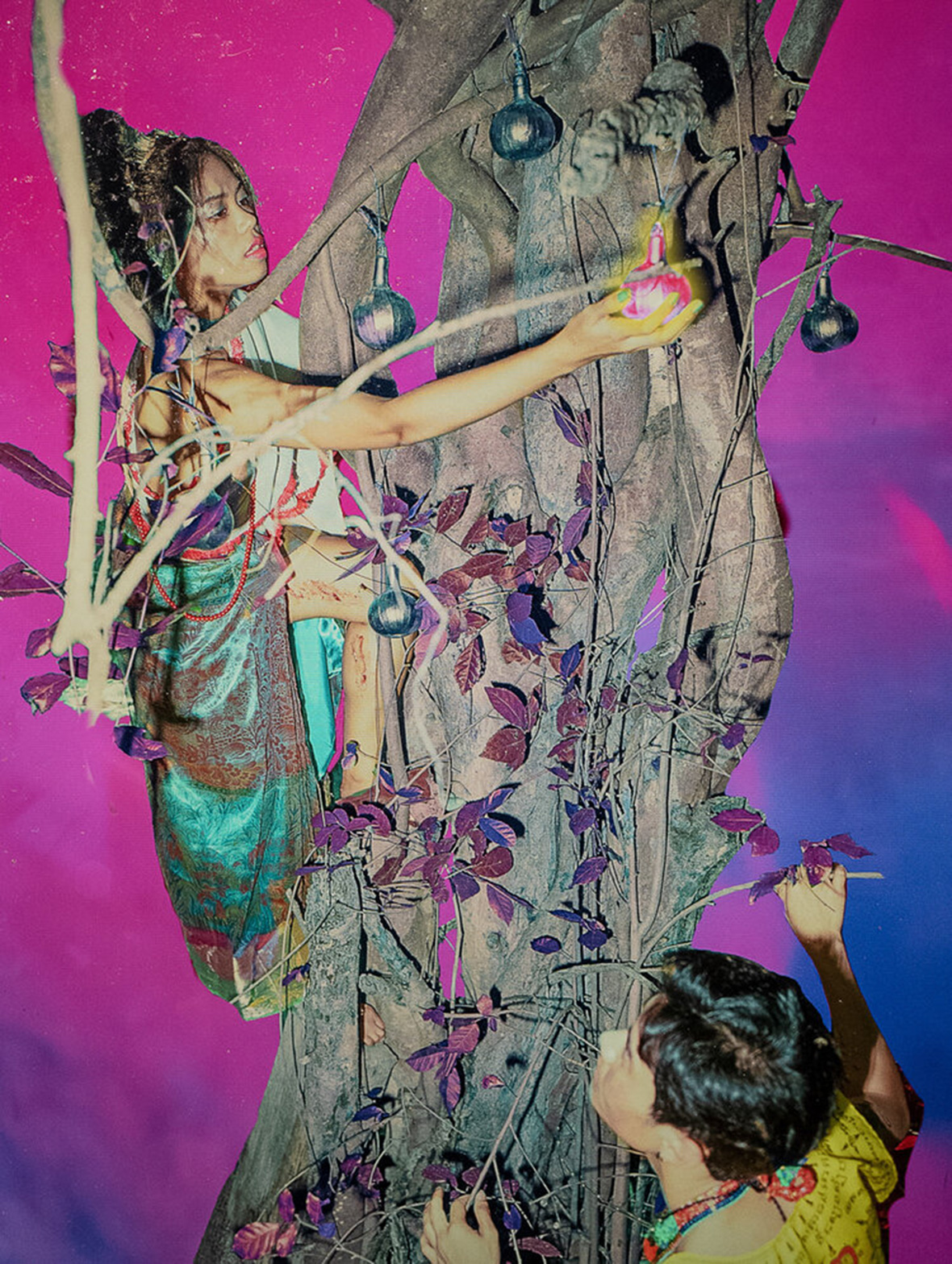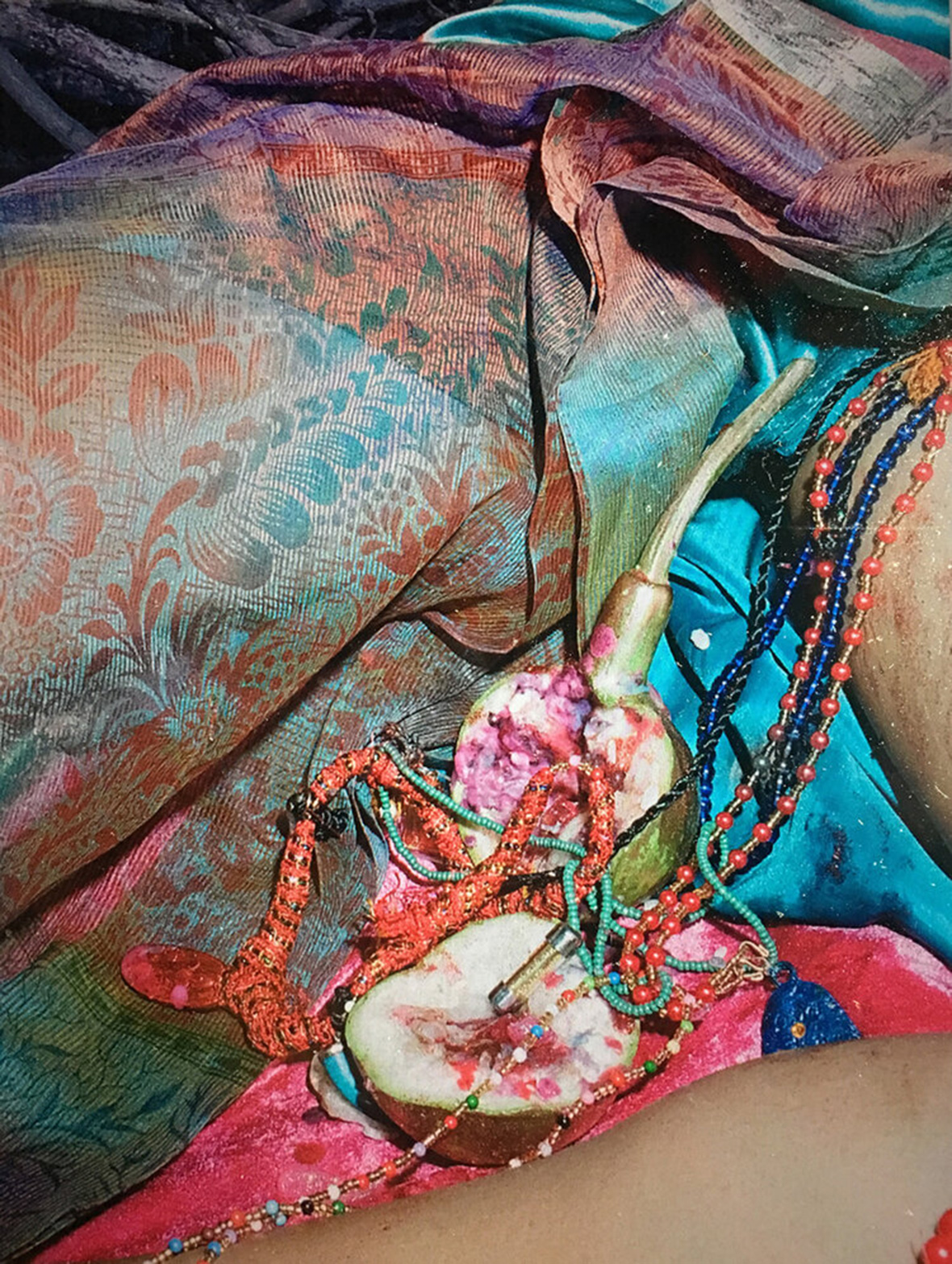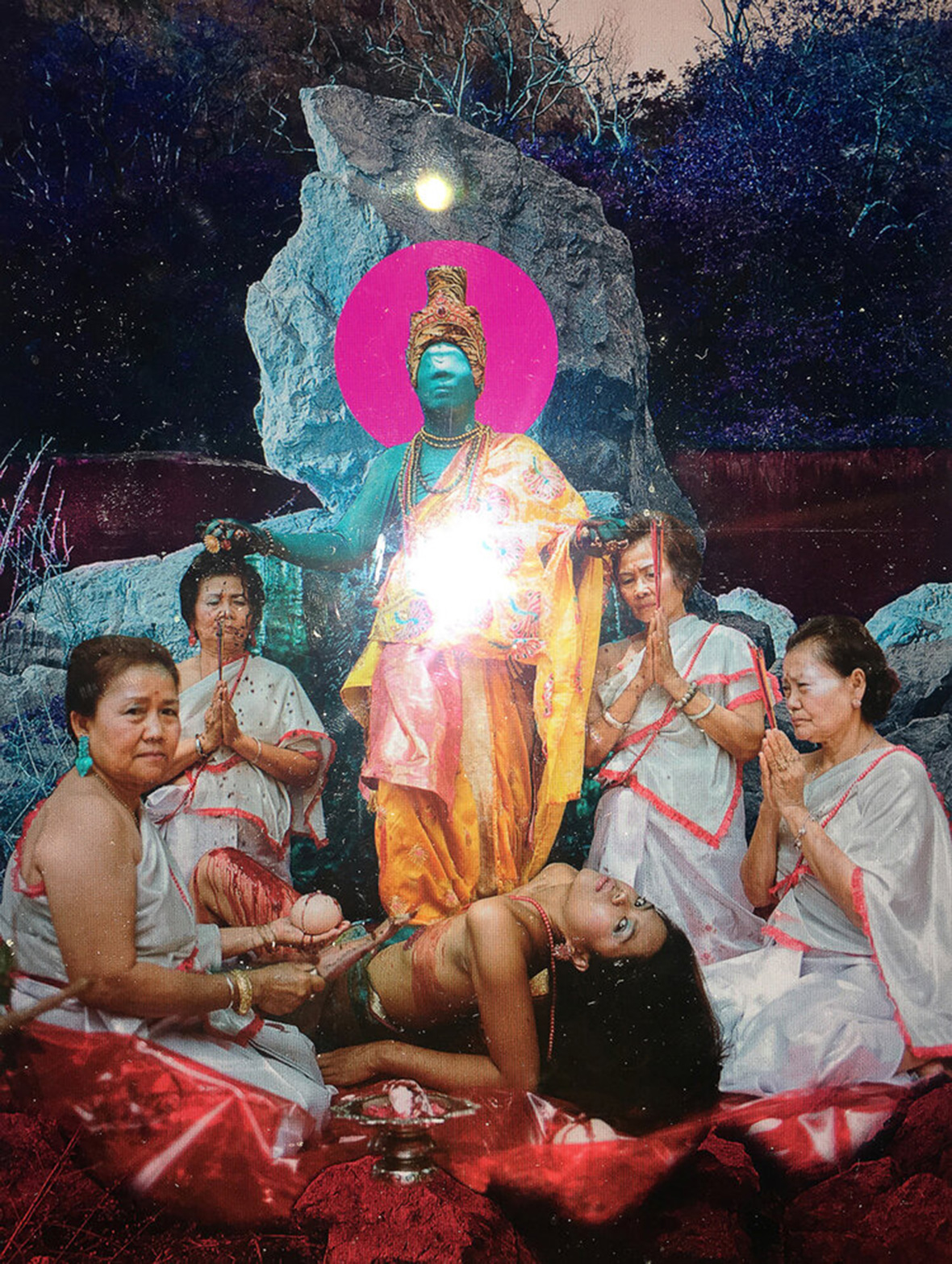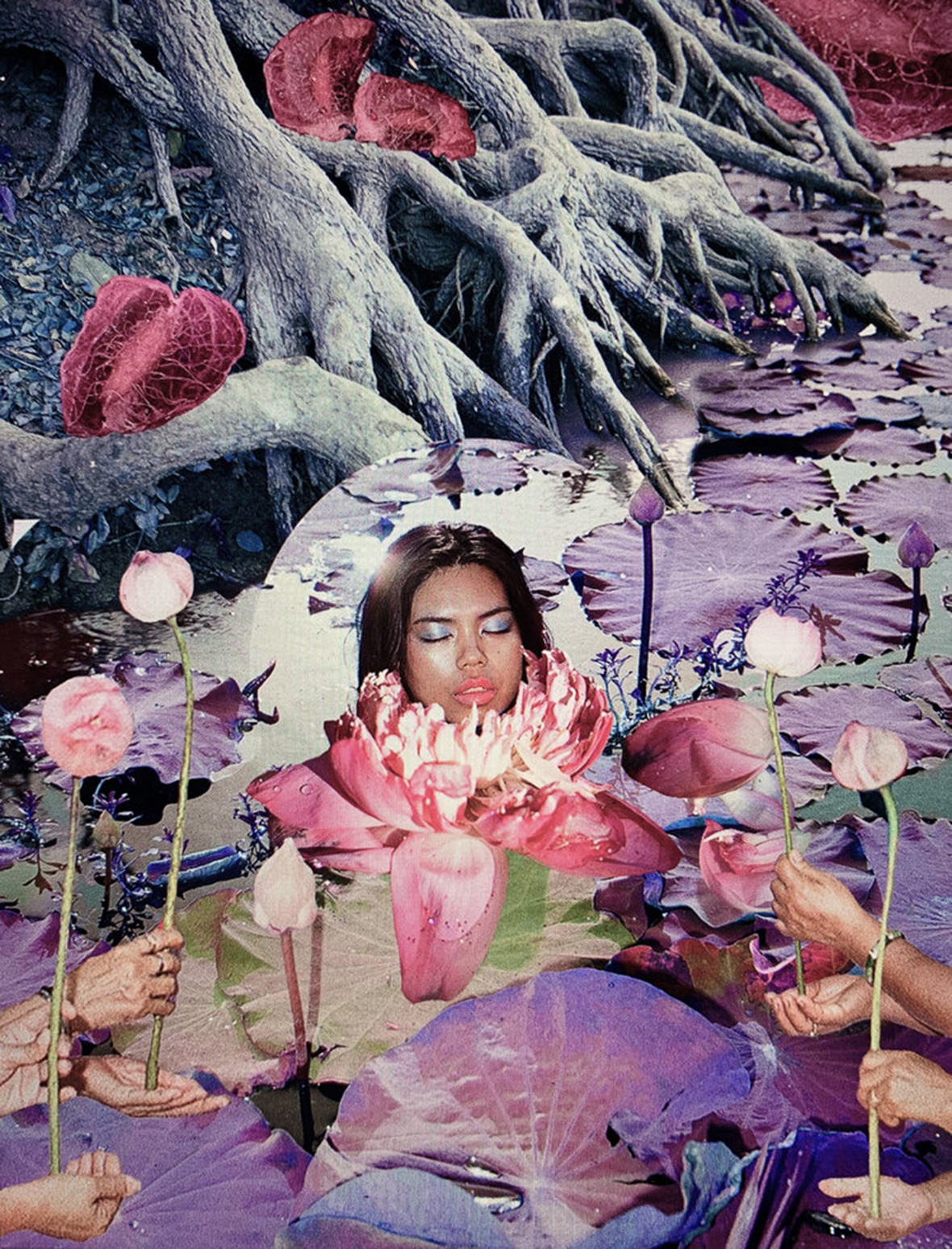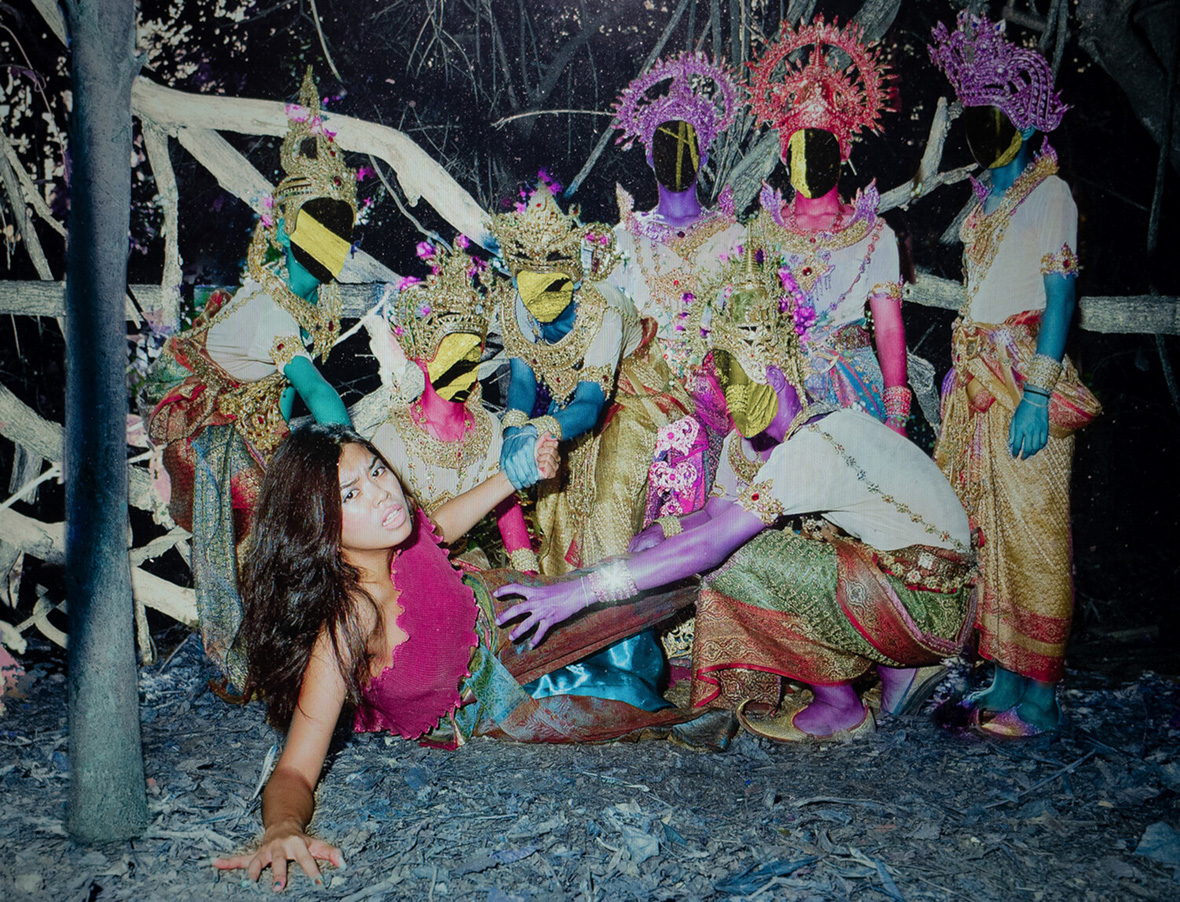
In Buddhism and Hinduism, the lotus flower is a symbol of purity. The flower is of particular significance in Thailand, a country where both religions thrive. But in the works of Thai artist Kamonlak Sukchai, the lotus is twisted into an object of ambiguity. Her latest multimedia project, Red Lotus, offers forth a surreal story of a virgin who eats a forbidden fruit. Like the best folklores, the narrative captures the imagination.
“Long ago, in a distant village, there was once a beautiful girl. The girl, born in the sacred waters of the Ganges River, had an air of allure that drove the men wild. The king sent her away, exiling her into the forest where she’d live with twelve ascetic monks who watched over the Ganges River. She had her first period while living in the forest and found herself craving a taste of a forbidden fruit. While the monks were busy at a ceremony, she climbed the holy tree to pluck the fruit. While scaling the branches, her period blood drips down on a sorcerer passing by, which strips him of his powers. He demands the girl to give her virginity in exchange. She agrees.
Not long after, the King held a baptism in the woods. As part of the ritual, the banished girl was expected to bathe herself in the waters. But the moment she stepped into the river, the water was dyed a crimson red, signifying her loss of purity. The village people were furious. They screamed and cursed at her, believing that only by punishing her will they be forgiven by the gods. They cut off her breasts and brutalized her genitalia. Before dying from her wounds, the girl prays to Indra, the king of gods in Hinduism, wishing to be reincarnated as a lotus flower in her next life so that she can finally be pure.”
出淤泥而不染的莲花在佛教和印度教中意味着纯洁,这使得它在这两大宗教占据主导地位的泰国有着特殊的符号意义。而在泰国艺术家 Kamonlak Sukchai 的作品《红莲》(Red Lotus)里,莲花的意义变得暧昧不明起来。
《红莲》讲述了一个圣洁少女偷食禁果的故事,和所有民间传说一样,它有着一个经典开头:
很久很久以前,在一个遥远的村庄,有一个美丽的少女。诞生在圣河的少女身上散发异香,令所有男子为之疯狂,国王因此下令将她放逐到森林深处,和隐士与十二名苦行妇一起守护圣池。很快,少女来了月经,她变得无法抑制想要偷尝林中圣果的欲望。趁着人们举行神圣仪式,她偷偷爬上神树,这时她的经血滴落在了一名路过的巫师身上,他因此丧失了全部的法力。他要求少女献出纯洁之身来弥补,少女答应了。
一天,国王决定在森林里举办一场盛大的圣洗仪式,作为仪式的一部分,少女要在圣池里沐浴。就在她走进圣池的一瞬间,池水突然变成了红色,变得不再纯洁。人们愤怒了,他们谴责她、惩罚她,为了寻求天神的谅解,他们切下她的双乳,扯下她的阴部。临死之时,少女向天帝因陀罗许下了最后一个愿望,她想来世转生成一朵莲花,从此只以纯洁的样貌存在。
This bizarre story, an amalgamation and reimagining of several Hindi folklores, was designed to be chock full of cliches. The symbols that appear in the series don’t depart from their traditional meaning. The lotus represents purity, red represents degeneracy, the gods as supreme rulers, and desire as punishable evils. As if these overused tropes weren’t enough, Sukchai dressed in the models in traditional Thai costumes. Bumping up the saturation to exaggerated levels in post-production, he looks to evoke the heightened colors of Thai temple designs.
But Red Lotus isn’t a celebration of divinity nor is it a homage to Thai folklore.
Growing up, Sukchai realized how much family, school, and society influenced her thoughts. People in Thailand have freedom of religion, but Buddhism remains the most popular. Statues of Phra Phrom, Indra, and Trimurti are commonplace across Thailand. Animism, the belief that objects and animals have spirits, is also popular in the country. The disparate religious beliefs that co-exist in Thailand are reflected in the country’s folklores, which in turn have shaped the cultural identity of the country.
Kamonlak 将她熟悉的民间故事和意象拼合起来,形成了一个充满陈词滥调的自创故事。故事里的每一个元素都恰到好处地映射了它们在民间故事里的经典角色:莲花代表纯洁,红色代表污浊,天神是至高无上的,而欲望是邪恶的,要被放逐和惩罚。好像唯恐这种陈词滥调还不够明显似的,Kamonlak 在影像语言里大量引用了泰国传统的民俗故事插图和影视剧的服装、布景以及高饱和配色。这种浓艳的颜色同样遍布泰国(尤其是内陆地区)街头的大小寺庙和神龛。
但 Kamonlak 的《红莲》不是要再一次重申信仰的力量。它不是对民间故事的简单复制,而是艺术家将她从小到大在家庭、学校和社会耳濡目染的民俗文化的糅合。泰国是一个宗教信仰自由的国家,虽然大多数民众信仰佛教,但泰国街头香火旺盛的四面佛、因陀罗和三相神又都是源自婆罗门教。除此之外,泰国民间还信奉万物有灵论,认为天地万物都有鬼神。各种信仰相互融合、吸纳,彼此之间的共生关系和权力关系又体现在用于教化民众、建构族群文化认同的民间故事上。
Sukchai is particularly interested in the way folktales blur the line between truth and fiction, the ways they shape people’s perceptions as they’re retold and passed down. Born in Ratchaburi, Thailand to a conservative household, her parents and schooling constantly taught her to be a “good woman.” The notion of “good” remains incredibly ambiguous to her, and she notes that notions of goodness in the country have been shaped by these folklores. The ethic and moral codes that people have built into the narratives felt at odds with her own thoughts and the world as she understood it.
民间故事如何模糊真实和虚构的界限?又是如何在一次又一次的并接和重述中改变我们的观点?Kamonlak 对这类话题的研究饶有兴致。1994年,她出生于泰国叻丕府一个保守家庭,父母为她取名“Kamonlak”,意为“莲花”。从小在家庭和学校接受的教育,包括父母和老师讲给她的民间故事,都告诉她要成为一名“好女人”。但这个概念对她来说太虚浮了,成人世界在民间故事里置入的意义,和她自己渐渐感受到的世界和身体显得格格不入。
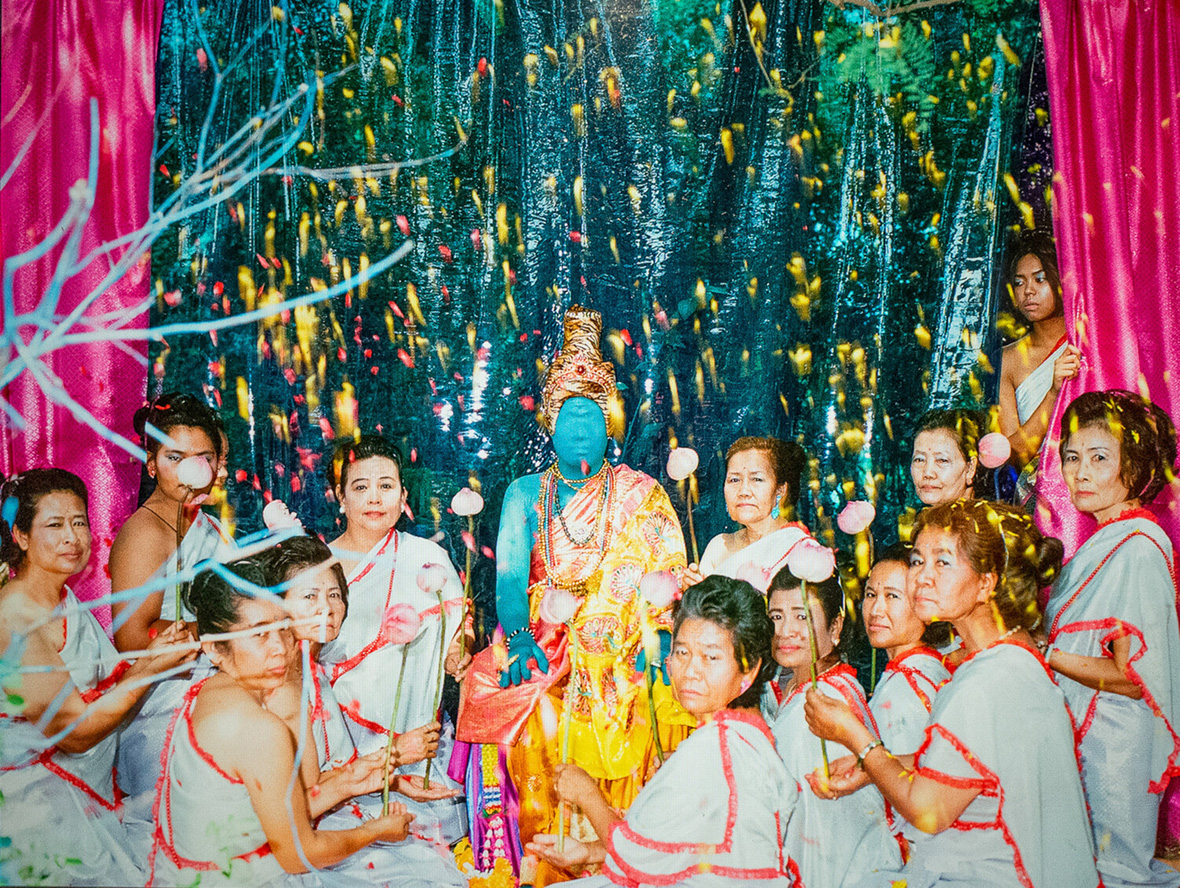
To better understand the current state of Thai society, Sukchai started studying the history of these folklores. The incongruous nature of her own beliefs and societal expectations is perhaps related to the contradictions of the stories themselves. Sex, for example, was a sacred ritual in animism, but with the introduction of Hinduism and Buddhism, it became taboo. Carnal desire became a mental hurdle that needed to be overcome.
Red Lotus revels in the absurdity of it all. To display the incongruity between these outdated fables and modern ideas, she sought to make the project feel as artificial as possible. If you examine these images closely, faint traces of moirés can be seen and even reflections. These unpolished qualities were intended—after adding the collage elements on her prints, she scans them and photographs them from the screen as the final touch. These subtle digital textures are a commentary on the way folktales are passed down from generation to generation, changing ever so slightly with each retelling.
为了更透彻地理解现在,她开始研究这些关于过去的传说,她发现自己感受到的不协调,某种程度上是源于这些故事本身不同意识形态的拉锯:以性举例,它在原始的万物有灵论里本是一种神圣的仪式,随着印度教和佛教的传入,性变成了禁忌,肉欲变成了需要克服的障碍。艺术家名字里的“莲花”也是,在佛教和婆罗门教里是无欲无求的极乐世界的符号,但在很多泰国文学作品里,莲花却象征着女性的私处,充满着情色意味。
在《红莲》里,Kamonlak 尽情强调种种陈词滥调,好让观看者发现其中的荒诞之处,以及过时的寓言和现代观念的不协调——换句话说,就是“越假越好”。她在作品中大量使用拼贴,指涉民间故事本身的拼贴属性。如果仔细看,会发现照片上有细密的纹理,甚至有几张还有明显的反光光斑(她管它们叫“噪点”),这是因为,Kamonlak 在 完成拼贴后,会再次拍摄屏幕上的照片,作为完成作品的最后一道工序。民间故事对社会潜移默化的形塑,在这些数字化的纹理下隐隐若现。
In Thai folklore, sex equates to temptation, and women—often the subject of temptation—are then punished for breaking taboo. Sukchai’s folklore retelling looks to subvert the stigmatized perception of femininity with a woman as the protagonist. In her story, she doesn’t look to shame desire, but celebrate it. The female protagonist’s predicament and outcome reflects Thai society’s attitude towards sex today. Sukchai doesn’t consider her work as feminist art, as she isn’t interested in being defined by the social constructs of gender norms. To her, the topic of desire and temptation isn’t bound by gender.
在民间故事里,性往往伴随着引诱,而女性往往承担了无法抗拒诱惑、冒犯禁忌后遭到惩罚的角色。Kamonlak 在她用摄影图像构建的新民间故事里,通过极力渲染少女的身体感受、在传统礼俗中被污名化的月经和代表月经的红色,试图扭转被污名化的女性形象,歌颂最原始的动物欲望。少女所遭受的放逐和惩罚也是身体和欲望在社会中的命运,连同少女最后的愿望都变得暧昧起来。但 Kamonlak 不认为自己是一名女性主义艺术家,她更希望自己不被社会建构的性别概念定义,正如她在作品里探讨的原始欲望,并没有性别之分。
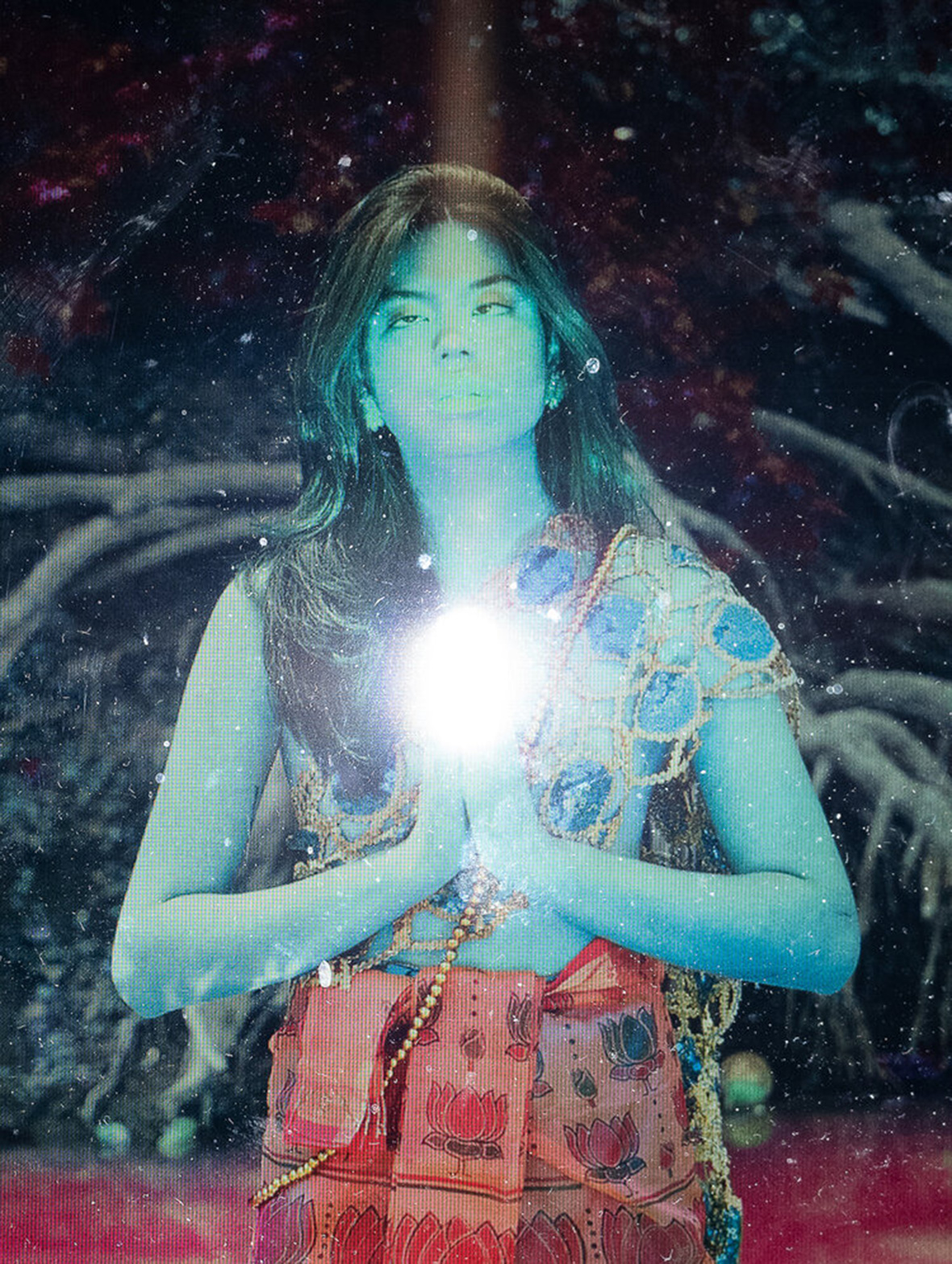
Like our stories? Follow us on Facebook and Instagram.
Website: www.kamonlaksukchai.org
Instagram: @kamonlak.sukchai
Contributor: Lu Yufan

